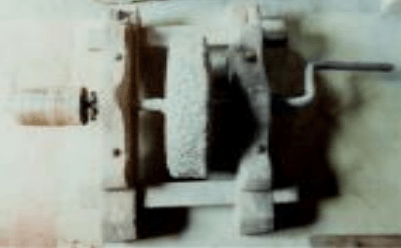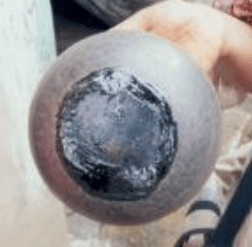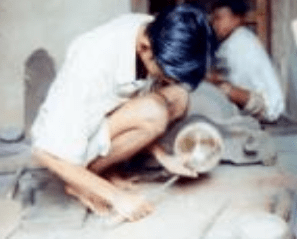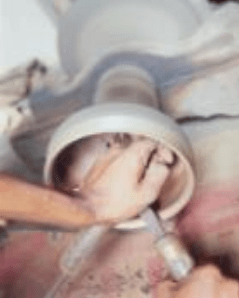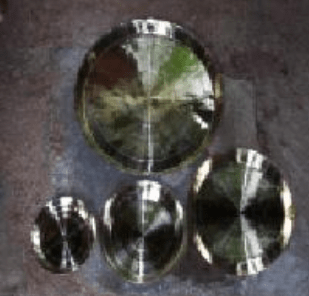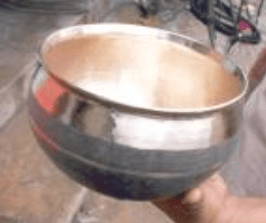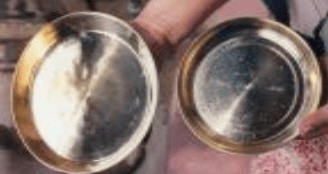DISTRICT MAP OF NAYAGARH:
bell metal craft comes from Kantilo, which is situated at a distance of 25kms from Nayagarh on the bank of river ‘Mahanadi’. The temple of Lord Nilamadhab, Lord Narayani, and the senic beauty attracts the tourists. It is also famous for its Brass and Bell-metal not only in India but also abroad.
BELL METAL CRAFT
Bell metal is dominantly used for making cooking ware, which is now supplemented with some decorative items. Orissa is the preserve of the ‘Kansari’ community, experts at this particular craft. The metal is so-called because the sound that it generates on hitting is similar to the sound of a bell.
This also explains why this metal is used to make ‘ghantas’ or bells for temples. The reason for traditionally making cooking ware and other kitchenware from the bell-metal alloy is that this alloy has several medicinal properties, which the food or water kept in them acquires.
These medicinal properties are derived from copper and zinc which are dominantly present in the bell-metal alloy. It is believed that regular use of these vessels can have long term effects towards preventing and relieving several ailments like gastric, diabetics, allergies, etc. The artisans who make bell-metal cooking ware also make items of brass and copper, however, bell-metal ware remains their specialty.
It is interesting to note that there is a strong sense of community among these artisans, they believe in the notion of sharing resources rather than competing for them, the artisans in each village specializes in only a particular item. An artisan who makes bowls is of course equipped to make plates and vice versa.
However, they prefer to specialize in one particular item and experiment and innovate with shapes, textures, and finishes.
CRAFT TRADITION OF BELL METAL:
Bell-metal has a great craft tradition that can be linked to lord Jagannath residing at Puri. The knowledge of making bell-metal products has been passed down from generation to generation.
Bell metal, which is dominantly a combination of copper and zinc, is considered to be a ‘shudh’or pure metal; this explains why utensils used at the Jagannath temple are only bell-metal utensils.
It is interesting to note that when a girl is married to this community, bell-metal ware forms an important part of her trousseau.
The local name for bell-metal is ‘kansa’ and the artisans who, before sunrise, give shape to molten bell-metal in order to make attractive utensils by their own hands through exhaustive manual labour are known as ‘kansari’. There is a reason why the kansari people start working much before the sunrise. The process of heating and beating the metal to make utensils generates so much heat that it becomes impossible for the craftsmen to carry on the work after mid-morning.
Traditionally, kansari people stay close to water bodies, as in the earlier days boat seemed the only mode of transportation. Also, there is so much of heat generated that water was needed essentially to cool down.
STUDY AREA COVERED: BELL METAL CRAFT AT KANTILO:
Kantilo is located on the banks of the river ‘Mahanadi’. From time immemorial, the metal craft particularly that of brass and bell-metal has been in practice in Kantilo; a place famous by its metal craft and for the temple of lord Neela Madhab, the origin of Lord Jagannath.
The Kansari people were brought here from ‘Kanya Kubaja’ by the ‘Gajapati Maharaja’ of Puri during 1804, as legend says, in order to supply ornamental, durable, and mineable brass and bell-metal utensils for Lord Jagannath’s daily use.
Kansaries continued their stay at Kantilo due to the abundance of natural resources like water, charcoal, metal, and navigation available here. Kantilo is famous for its metal craft not only in India but also abroad.
RAW-MATERIALS USE FOR BELL METAL CRAFT:
Ingots of different sizes
Bell metal is made from a combination of copper, zinc, tin, iron, and mercury. 1kg of copper is mixed with 270-300gms of tin, 50gms of zinc, 5gms of iron, and a pinch of mercury. The metals are mixed together and worked into ingots. The craftsmen buy their raw materials from the local ‘Mahajan’ in a bulk (approx 15-20kgs) which lasts them for 3-4 days.
TOOLS:
Hathoda (hammer), 2 types of shanwashi (tong) areused, one is small and the other one is big, cutter, pittini, chenni, puaro (iron wedge ).
PROCESS:
After the different kinds of metals are mixed together and worked into ingots, the ingots are heated to make them malleable, and are then beaten into the desired shape; the size of the ingots differs with different products. The process of heating the metal alloy and beating it further into shape continues till the required shape and size have been achieved.
Beating the ingots
The metal is beaten with an iron hammer that is usually between 500-700gms in weight. Usually, 4 ingots are taken one of top of the other in a set for the process of heating and beating the metal and later taken out one after the other.
Removing the ingots one by one
After the required shape has been created, the bell metal item is left to cool. The color of the ware is sooty black. Thereafter, coal-tar is applied at the bottom of the vessel and is then stuck onto the polishing machine.
Polishing tools
Though the outside is most often left a natural sooty black, the inside surface of the cooking ware is scratched on the polishing machine and the black coating is peeled off. A metallic finish, warm yellow-gold color is thus achieved. This craft is highly labor-intensive, at a time about four craftsmen work in making just one product.
Unlike other cast metal objects, the beaten kind of metalware cannot break; it will bend if extreme heat or pressure is applied to it but the process of beating enhances its malleability and tensile strength to a great extent. The only points along which a beaten cooking vessel can be broken are along the welding lines.
Polishing is mostly done on the inside of bell-metal ware
PRICING OF BELL METAL CRAFT WARE:
Bell metal ware is quite expensive. Metal cooking ware is done according to the weight of product and
not according to the size. The total cost of a product includes 75% of labour cost besides the other variables taken into consideration while costing.
MARKET OF BELL METAL CRAFT:
For the craftsmen the local mahajan is his market. The craftsman buys his raw-materials from the mahajan and sells the final product to the mahajan. There is no proper exhibiting or showroom facility for these products. These craftsmen have also not received any help from government in the form of any fund or grant. The craftsmen of Kantilo are very poor and neglected by the society and are in the list of backwards even though the existence of super intellectual artistic knowledge in the craft lies with these artisans. Due to the lack of facilities available to them, the number of bell-metal artisans is continuously decreasing.
CHANGES OVER THE YEARS, TECHNOLOGICAL CHANGES:
There have not been many technological changes in this field. However, new mechanical blowers to blow are into the kiln having come into the picture. Also earlier, polishing was done by scratching the ware with a knife-like instrument called ‘neheni’ in the local language. Nowadays, new machines have come in, on which the ware is stuck with the help of coal-tar and then polished.
DESIGN OF BELL METAL CRAFT:
Earlier the products made out of the bell-metal were rather plain and simple but these days some kind of ornamentation has also started taking place. Traditionally only cooking ware was made out of this metal but now or items on order and decorative pieces are also being made. These days few design stores have also ventured in, KAARU at Delhi, is one such example, displays many of the bell-metal products made in Kantilo.
MARKET OF BELL METAL CRAFT:
There has not been much of a market increase for the Kansari people. As it is an expensive product which has various cheaper substitutes available, it becomes difficult for the craftsmen to create a steady market for his products.
PRODUCT RANGE:
As is apparent, the primary product range made out of bell-metal artisans is cooking ware, usually in the shape of pots with a wide bottom, plates in the style of traditional Indian thali etc. The modern product range include decorative items, decorated plates with relief work done on them, bowls of various sizes and shapes, glasses, water jugs, specially designed ‘pooja thalis’ etc. Products made for exhibitions are made keeping in mind the correct proportion and are polished twice to get an extra shine.
Thali’s of different sizes
KANSARI SAMAJ:
Kansari Samaj was set up in 1973, in Kantilo, Orissa, in order to promote the well-being of the kansari or Bell Metal artisans. This organization has about 1000 artisans under it. The aims and the objectives of the ‘Kansari Samaj’ are as follows:
a) To create unity among the Kansari artisans,
b) To encourage their ability,
c) To develop both crafts as well as the socio-economic conditions of the Kansari artisans
d) To export Brass and Bell Metal products,
e) To develop proper marketing strategies, and
f) To receive a genuine price of the products under Brass and Bell Metal products.
Although this organization was set up for a noble cause, due to paucity of funds, inefficiency to create a demand for Bell Metal products, non-availability of proper marketing and servicing extension centers, have made the organization almost non-functionary.










